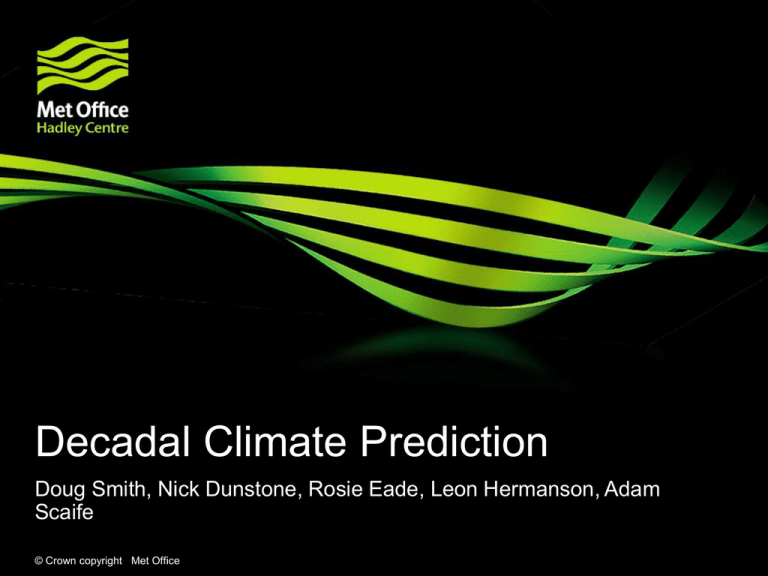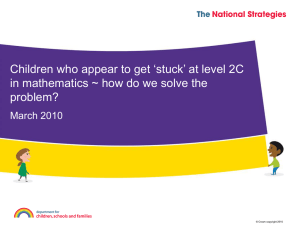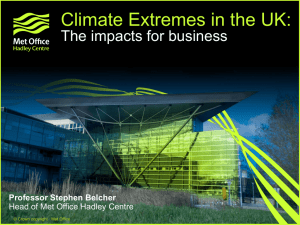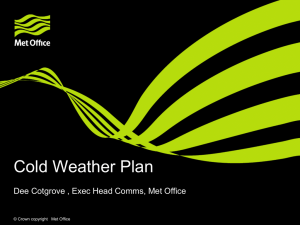presentation - eu-Thor
advertisement

Decadal Climate Prediction Doug Smith, Nick Dunstone, Rosie Eade, Leon Hermanson, Adam Scaife © Crown copyright Met Office Contents • Motivation for decadal predictions • Practical issues • Initial results • Future priorities © Crown copyright Met Office Decadal prediction UK 9-year mean temperature “Global warming” trend Natural internal variability, or errors in simulation of external forcing • Need to take into account all sources of predictability • External forcing: greenhouse gases, aerosols, volcanoes, solar • Natural internal variability – need to start predictions from the current state of the climate system © Crown copyright Met Office El Niño Southern Oscillation (ENSO) © Crown copyright Smith et al, 2011Met Office Atlantic multi-decadal variability (AMV) © Crown copyright Smith et al, 2011Met Office Impact of Atlantic on Europe? © Crown copyright Met Office (Sutton and Dong 2012) Impact of Atlantic on Europe? © Crown copyright Met Office (Sutton and Dong 2012) Potential climate impacts of North Atlantic sea surface temperatures North Atlantic SST Sahel rainfall India rainfall Hurricanes © Crown copyright Met Office 2006) (Zhang and Delworth, Atlantic ocean circulation • Idealised experiments suggest that North Atlantic ocean currents are potentially predictable on decadal timescales Full depth observations 10 20 © Crown copyright Met Office 30 Year 40 Observations in upper 2000m 50 10 20 30 40 50 (Dunstone and Smith 2010) Contents • Motivation for decadal predictions • Practical issues • Initial results • Future priorities © Crown copyright Met Office Sub-surface ocean observations 1960 1980 2007 • Need historical tests to assess likely skill of forecasts • Far fewer sub-surface ocean observations in the past © Crown copyright Met Office Uncertainties Projections of Dec-Feb decadal rainfall • Large uncertainties in model response to external forcing • Need multi-model ensembles • and to understand physical mechanisms © Crown copyright Office 2011) (Hawkins and Met Sutton, Uncertainties Ensembles of forecasts: • Uncertainties in the initial conditions • Model errors An optimistic view: Forecasts Temperature Actual Time Not accounted for: • Uncertainties in greenhouse gas and aerosol emissions • Volcanoes, changes in solar output © Crown copyright Met Office Contents • Motivation for decadal predictions • Practical issues • Initial results • Future priorities © Crown copyright Met Office Surface temperature predictions (five year means) Skill of initialised predictions Initialised - Uninitialised • Skilful almost everywhere (positive correlations) • Mostly due to external forcing • Initialisation gives improved skill mainly in North Atlantic and tropical Pacific © Crown copyright Office (Smith et al.Met 2010) AMOC at 45oN in assimilation experiments • No historical observations – must rely on models • Consistent signal: increase from 1960 to 1995, decrease thereafter • Agrees with related observations © Crown copyright Met Office (Pohlmann et al. 2011, in revision) AMOC at 45oN in hindcast experiments Initialised hindcasts Externally-forced hindcasts • Some skill in initialised predictions, but not in uninitialised predictions (Pohlmann et al. 2011, in revision) © Crown copyright Met Office North Atlantic sub-polar gyre Meridional heat Overturning (SPG) transport circulation SPG 500m temp Observations Initialised (DePreSys) Uninitialised (NoAssim) • Improved skill for 1995 rapid warming results from initialisation of increased Atlantic overturning circulation and meridional heat transport © Crown copyright (Robson et al. 2012, Met alsoOffice Yeager et al. 2012) Precipitation Temperature Impacts of 1995 SPG warming • Initialisation impacts temperature and precipitation following the 1995 SPG warming © Crown copyright Met Office (Robson et al. 2012) Tropical storm predictions beyond the seasonal range Initialised Uninitialised Persistence Skill from external forcing and initialisation 5 year means (Smith et al. 2010) Initialised Uninitialised Observations © Crown copyright Met Office Remote influences on Atlantic hurricanes (Smith et al. 2010) © Crown copyright Met Office Skill of temperature extremes • Hindcasts start Nov 1st each year 1960 to 2005, with 9 ensemble members • Assess extremes using daily data • Moderate extremes (10th percentile) • 4 definitions (e.g. cold days, cold nights, warm days, warm nights) © Crown copyright (Eade et al. in press)Met Office Skill of wet extremes • Assessed from daily data • Wet: precipitation rate greater than 90th percentile (of rainy days) © Crown copyright (Eade et al. in press)Met Office Contents • Motivation for decadal predictions • Practical issues • Initial results • Future priorities © Crown copyright Met Office Multi-model forecasts of 2011 © Crown Met Office (Smith et al.copyright submitted) Impact of initialisation 2012-16 Initialised – uninitialised, stippled where not significant © Crown Met Office (Smith et al.copyright submitted) Solar variability : winter (solar min – solar max) Model Observations Winter sea level pressure, solar min minus solar max © Crown copyright Office Ineson et al., 2011,MetNGEO Arctic Sea Ice Recent Winter Pressure Arctic Sea Ice is systematically melting Last few years have seen record melt Observed climate records and climate models indicate cold easterly winter winds in response to ice melt Reproduced by Climate Model © Crown copyright Met Office Better models: skill for temperature years 2-5 New model © Crown copyright Met Office Old model Difference Summary • Already have skill from climate change signal Skilful predictions of extreme temperatures • Initialisation improves N. Atlantic and tropical Pacific Improved predictions of AMOC and SPG • Skilful predictions of tropical Atlantic storms • Emerging importance of external factors: aerosols, volcanoes, solar, greenhouse gases via sea ice? • Need improved models to predict atmospheric response over land better • Need to understand physical mechanisms to gain confidence in forecasts © Crown copyright Met Office Thank you Any questions? © Crown copyright Met Office










